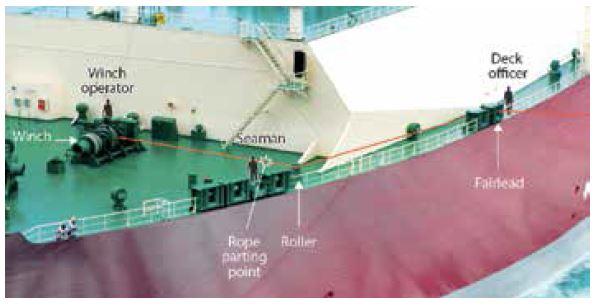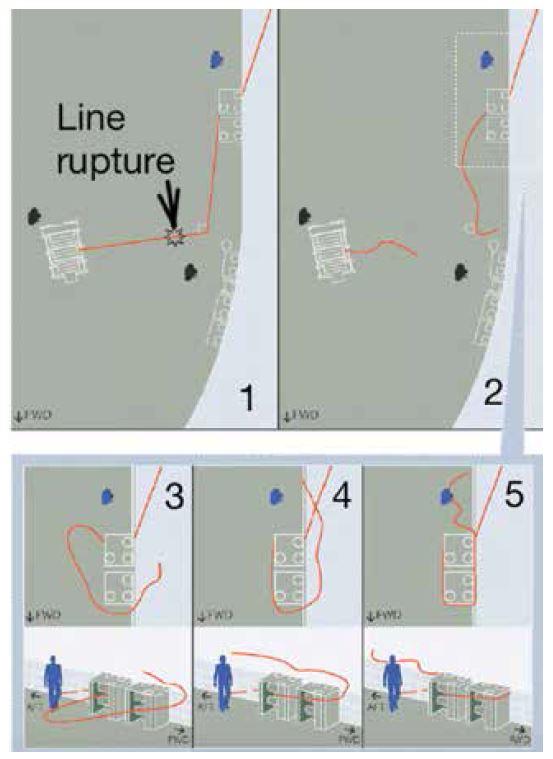201614 Snap-back slipup
Edited from the OCIMF official bulletin The Hazards of Snap-back, Sept 2015
A large LNG carrier was being warped into position by tensioning the forward back springs. The deck officer in charge of the forward mooring party was standing aft of the fairlead through which the spring lines passed. He was directing operations by signalling to a seaman who was located forward. From this position the seaman was able to relay the signals to the winch operator, who could not see the deck officer. While under tension, the mooring line parted inboard from a pedestal fairlead. The section of the line between the break and the port shoulder roller fairlead struck the deck officer on the head as it whipped back before going overboard through the fairlead. The deck officer was found lying unconscious forward of the roller fairlead. He had sustained multiple skull fractures. The mooring line that failed was a 44-millimetre-diameter sheathed ultra-high-modulus polyethylene line. The line was fitted with a 22-metre-long polyester/polyethylene tail. The section of line in use between the winch and the connection with the tail was approximately 68 metres long.
Lessons learned
- Snap-back zones can be complex and sometimes counter-intuitive. In this case, computer modelling was used after the accident to assess the dynamic trajectory of the entire length of the rope from its point of failure. The modelling indicated that it was highly probable that the rope would go aft of the roller fairlead and wrap around it before finally going outboard.
- Synthetic tails provide additional elasticity in the mooring system and serve to reduce peak dynamic loads. As a result of the tail’s elasticity, the elongation of the total mooring line under tension is increased; this introduces considerable stored energy that will be released if the mooring line fails. The snap-back characteristics of this type of mooring line (ultra-high-modulus polyethylene), initially considered to be relatively benign, will be heavily influenced by the addition of the synthetic tail.
- The length of tail fitted to the mooring line will influence the amount of stored energy in the system. The longer the tail, the greater the elasticity and stored energy, and the greater the likelihood of recoil and snap-back should the mooring line fail.
- Depending on where the line breaks, there can be snap-back zones in multiple locations. Actual mooring arrangements on board require specific analysis to determine the most likely snap-back zones.
- The best protection during mooring operations is not to have line ruptures. Careful inspection, use and well-considered modifications, such as adding synthetic tails, are the best guarantee of safe operation.


Reader's comments
Please note that high modulus polyethylene (HMPE) line is subject to parting when overheated. The dangers of surging these Class II lines is emphasised in every manufacturer’s safety bulletin, even around a pillar roller fair lead. Without chafing gear, abrasion from external sources slows the outer layers on helical twisted rope, which in turn allows the inner strands to build up heat as they surge at a different speed, causing them to melt. Eventually the rope loses tensile strength and simply pulls apart.
The introduction of pennants that stretch, to lessen the effects of the Class II rigidity on the deck machinery, has now re-introduced snap-back risks for HMPE ropes. The danger is the lack of understanding of the mechanics of these lines and the failure to understand the limitations, especially on abrasion, of these new super lines.


